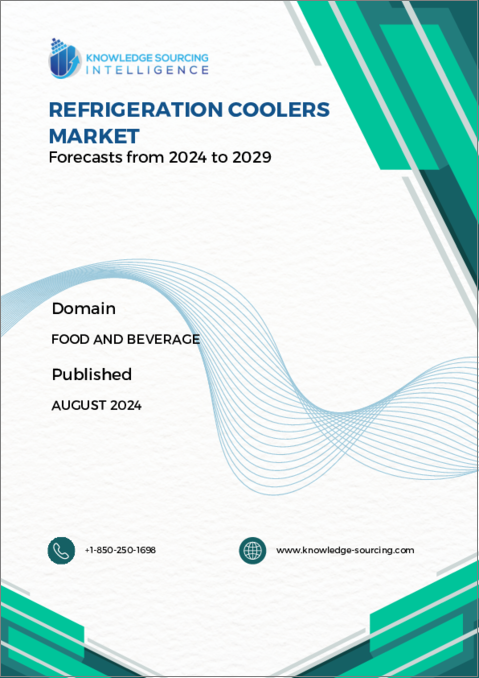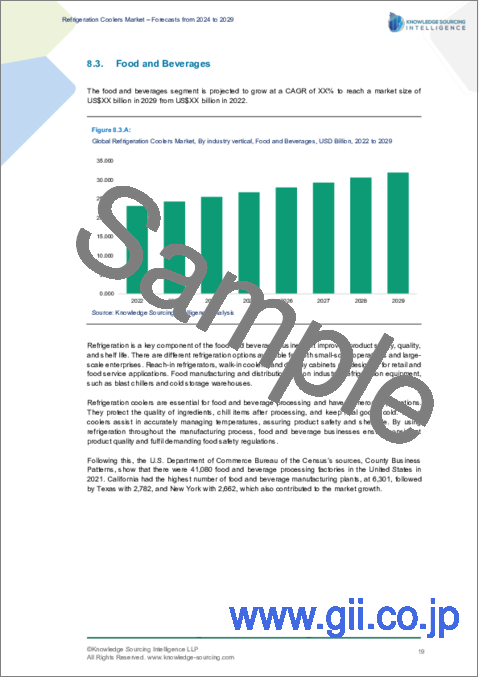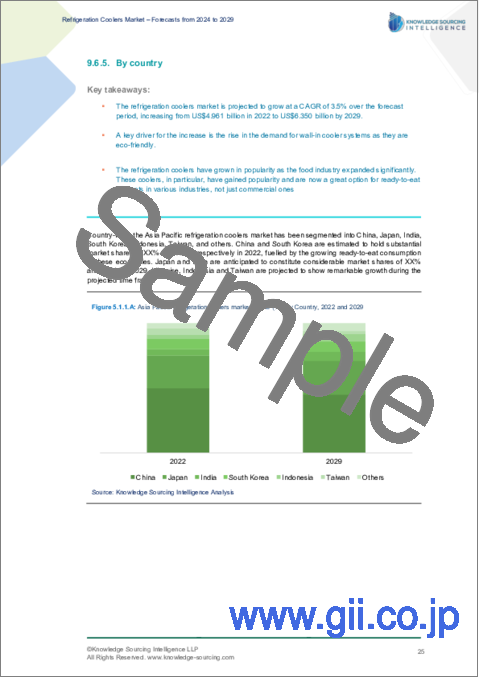|
|
市場調査レポート
商品コード
1321608
冷凍クーラー市場-2023年から2028年までの予測Refrigeration Coolers Market - Forecasts from 2023 to 2028 |
||||||
カスタマイズ可能
|
|||||||
| 冷凍クーラー市場-2023年から2028年までの予測 |
|
出版日: 2023年07月03日
発行: Knowledge Sourcing Intelligence
ページ情報: 英文 145 Pages
納期: 即日から翌営業日
|
- 全表示
- 概要
- 目次
冷凍クーラー市場のCAGRは3.21%で、2021年の48億4,500万米ドルから2028年には60億4,400万米ドルに成長すると予測されています。
冷凍クーラーは、物体や空間から不要な熱を取り除き、製品を理想的な温度条件で保管または輸送するのに役立ちます。冷凍ユニットは冷凍システムの主要コンポーネントです。冷媒は不要な熱を吸収し、冷却プロセスを助ける冷却剤です。この市場成長の主な促進要因には、冷凍食品や加工食品の需要増加、FMCG製品の需要拡大などがあります。
冷凍食品や加工食品の需要の急増は、市場成長にプラスの影響を与えています。
最近、冷凍食品や加工食品、飲食品の需要が顕著に増加しています。この背景には、新興諸国におけるライフスタイルや食生活の変化、都市化の進展があります。人々のライフスタイルが変化し、多忙で要求が厳しくなっているため、準備の時間や材料をあまり必要としない冷凍食品、加工食品、すぐに食べられる食品に目を向ける人が増えています。そのため、こうした製品の需要が高まっており、ひいてはこうした製品の倉庫保管、輸送、棚入れに必然的に必要とされる冷凍クーラーのニーズも高まっています。さらに、スーパーマーケットや食料品店の出店数の増加など、小売分野の成長も冷凍クーラー市場の開拓を後押ししています。これらの小売店では、様々な商品を保管するために業務用の冷凍クーラーが必要となるからです。冷却技術の進歩や、動きの速い消費財やファーストフードの需要の伸びも、冷凍クーラーの需要を後押しします。このような努力により、冷凍クーラー市場の主要企業は、過去数年間で収入が増加しています。例えば、ダイキンインターナショナルの年次報告書によると、冷凍クーラーを含む空調部門は、2021年から2022年にかけて17%以上増収し、2022年の総収入は約2兆8,285億円となっています。
高いメンテナンス水準が業界の拡大を抑制すると予想されます。
この業界が直面する重要な課題は、冷凍クーラーに要求される高レベルのメンテナンスに関するもので、製品需要に悪影響を及ぼすため、業界の成長の妨げとなっています。さらに、適切なメンテナンスが行われないために技術的な問題が発生する可能性があることも、この市場の成長にとって大きな抑制要因となっています。また、冷蔵冷却に関連するリスクとして、内部に保管されている内容物に悪影響を及ぼす内部漏れなどもあり、これも同市場の成長を阻害する要因となっています。
市場動向:
- 2021年2月、Blue Star社はインドでワクチンの保管と輸送を支援するために設計された業務用冷蔵製品の新ラインナップの発売を発表しました。これらの冷蔵クーラーは、完璧な温度条件を維持するのに役立ち、最大2日間電気なしで使用できるため、全国的なワクチン流通チェーンを強化するのに理想的です。
- 2021年11月、エンブラコは新しいコンデンシング・ユニット・ポートフォリオの一環として、食品小売およびフードサービス分野に特に重点を置き、様々な商業用冷蔵のニーズを満たすことを目的とした様々なバリエーションを持つ、新しい冷蔵ソリューション・レンジの発売を発表しました。製品は複数の寸法で提供されるため、購入者はニーズに応じて柔軟に購入することができます。
- 2023年3月、ElanProは外食産業向けのエネルギー効率に優れたクーラーの新製品を発売しました。これらの製品は、飲食品業界各社が生産物の品質を向上させ、エネルギー効率を高め、結果として収益性を向上させることを目的としています。
アジア太平洋地域が冷凍クーラー市場で大きなシェアを占めると予想されます。
アジア太平洋地域は大きな市場シェアを占めると予想され、予測期間中も同様の動向が続くと思われます。この市場シェアは、中国、日本、韓国、インドといった同地域の主要経済圏の産業・商業部門からの冷凍ソリューションに対する需要が牽引しています。生活習慣の変化により、中国とインドでは人口が多く、食品、特に冷凍食品や加工食品の需要が増加しています。これらの要因も、飲食品業界における業務用および小売用冷凍クーラーのニーズの急増に寄与しています。冷凍クーラーは、飲食品や、ワクチンや医薬品など精密な温度管理が必要な製品の倉庫保管や輸送にも需要があります。さらに、北米と欧州市場は緩やかな成長が見込まれています。米国の冷凍クーラーに対するニーズは、組織化された小売部門の店舗の大規模なネットワークと、肉食人口が多いため動物由来の食品加工向け用途により、安定した成長が見込まれています。
目次
第1章 イントロダクション
- 市場概要
- 市場の定義
- 調査範囲
- 市場セグメンテーション
- 通貨
- 前提条件
- 基準年と予測年のタイムライン
第2章 調査手法
- 調査データ
- 調査プロセス
第3章 エグゼクティブサマリー
- 調査ハイライト
第4章 市場力学
- 市場促進要因
- 市場抑制要因
- ポーターのファイブフォース分析
- 業界バリューチェーン分析
第5章 冷凍クーラー市場:コンポーネント別
- イントロダクション
- 蒸発器・エアクーラー
- 凝縮器
第6章 冷凍クーラー市場:冷媒の種類別
- イントロダクション
- HFC/HFO
- NH3
- CO2
- グリコール
- その他
第7章 冷凍クーラー市場:用途別
- イントロダクション
- 商業用
- 産業用
第8章 冷凍クーラー市場:業界別
- イントロダクション
- 輸送・物流
- 食品・飲料
- 医療
- その他
第9章 冷凍クーラー市場:地域別
- イントロダクション
- 北米
- 米国
- カナダ
- メキシコ
- 南米
- ブラジル
- アルゼンチン
- その他
- 欧州
- ドイツ
- フランス
- 英国
- スペイン
- その他
- 中東・アフリカ
- サウジアラビア
- アラブ首長国連邦
- イスラエル
- その他
- アジア太平洋
- 中国
- 日本
- インド
- 韓国
- インドネシア
- 台湾
- その他
第10章 競合環境と分析
- 主要企業と戦略分析
- 新興企業と市場収益性
- 合併、買収、合意およびコラボレーション
- ベンダー競争力マトリックス
第11章 企業プロファイル
- Johnson Controls International PLC
- Emerson Electric Co.
- Carrier Global Corporation
- Daikin Industries, Ltd.
- The Danfoss Group
- Lennox International, Inc.
- Guntner GmbH & Co. KG
- Evapco, Inc.
- Baltimore Aircoil Company Inc.
- Koxka
The refrigeration coolers market is expected to grow at a CAGR of 3.21% from US$4.845 billion in 2021 to US$6.044 billion in 2028.
A refrigeration cooler helps remove unwanted heat from objects or space and assists in storing or transporting products in ideal temperature conditions. The refrigeration unit is the main component of a refrigeration system. A refrigerant is a cooling agent that absorbs unwanted heat and helps the cooling process. The major drivers for the growth of this market include increased demand for frozen and processed foods and growing demand for FMCG products.
The surge in demand for frozen and processed foods is positively impacting the market growth.
There has been a noticeable increase in the demand for frozen and processed food and beverage items recently. This can be attributed to changing lifestyles and dietary habits and rising urbanization in developing countries. As people's lifestyles are changing and becoming increasingly hectic and demanding, more people are turning towards frozen, processed, and ready-to-eat food products that do not require much preparation time and materials. This is driving the demand for such products, which, in turn, is the need for refrigeration coolers that are necessarily required in the warehousing, transportation, and shelving of most of these products. Additionally, growth in the retail sector, including an increase in the number of supermarket and grocery store openings, is also driving the development of the refrigeration coolers market, as these retail stores require commercial refrigeration coolers for storing various products. Advancements in cooling technologies and growth in demand for fast-moving consumer goods and fast food will also drive the demand for refrigeration coolers. Due to such efforts, key businesses in the refrigeration cooler market have seen an increase in income over the past few years. For instance, according to their yearly reports, the air conditioning segment of Daikin International, which includes refrigeration cooling, increased revenue by over 17% from 2021 to 2022 and produced total revenues of roughly ¥2,828.5 billion in 2022.
A high maintenance level is expected to restrain the industry's expansion.
A significant challenge faced by this industry relates to the high levels of maintenance required by refrigerating coolers which act as a hindrance to the growth of the industry as it negatively impacts the demand for the product. Additionally, the chances of technical problems arising due to a lack of proper maintenance is another major restraint for the growth of this market. There are also other risks associated with refrigeration cooling, such as internal leakages that can negatively affect the contents stored within that act as hindrances to the growth of this market.
Market Developments:
- In February 2021, Blue Star announced the launch of its new line of commercial refrigeration products designed to aid in storing vaccines and assisting in their transportation in India. These refrigerating coolers are ideal for boosting the vaccine distribution chain nationwide since they help maintain the perfect temperature conditions and can even continue without electricity for up to 2 days.
- In November 2021, Embraco announced the launch of its new range of refrigeration solutions as part of its new condensing unit portfolio, with different variants aimed at fulfilling various commercial refrigeration needs, with a special focus on the food retail and food service segments. The products will be available in multiple dimensions, giving some purchasing flexibility to the buyers as per their needs.
- In March 2023, ElanPro launched its new line of energy-efficient coolers for the food service industry. These products are aimed at helping players in the food and beverage industry to improve the quality of their output, enable them to be energy-efficient and consequentially increase profitability.
The Asia Pacific region is expected to hold a significant share of the refrigeration cooler market.
Asia Pacific is expected to constitute a significant market share, and similar trends will be followed in the forecast period. This market share is being driven on account of demand for refrigeration solutions from the industrial and commercial sectors in the region's major economies, such as China, Japan, South Korea, and India. Due to changing habits, large populations in China and India also relate to increased demand for food products, specifically frozen and processed food products. These factors also contribute to a surge in the need for refrigeration coolers for commercial and retail use in the food and beverage industry. There is also a demand for refrigeration coolers for warehousing and transportation of food and beverage items and other products that require precise temperature control, such as vaccines and medicines. Additionally, North American and European markets are expected to experience moderate growth. The need for refrigeration coolers in the United States is expected to experience steady growth due to its large network of organized retail sector stores and animal-based food processing applications to cater to a large meat-eating population.
Market Segmentation:
By Component
- Evaporators & Air coolers
- Condenser
By Refrigerant Type
- HFC/HFO
- NH3
- CO2
- Glycol
- Others
By Application
- Commercial
- Industrial
By Industry Vertical
- Transportation and Logistics
- Food and Beverage
- Healthcare
- Others
By Geography
- North America
- USA
- Canada
- Mexico
- South America
- Brazil
- Argentina
- Others
- Europe
- Germany
- France
- United Kingdom
- Spain
- Others
- Middle East And Africa
- Saudi Arabia
- UAE
- Israel
- Others
- Asia Pacific
- China
- Japan
- India
- South Korea
- Indonesia
- Taiwan
- Others
TABLE OF CONTENTS
1. INTRODUCTION
- 1.1. Market Overview
- 1.2. Market Definition
- 1.3. Scope of the Study
- 1.4. Market Segmentation
- 1.5. Currency
- 1.6. Assumptions
- 1.7. Base, and Forecast Years Timeline
2. RESEARCH METHODOLOGY
- 2.1. Research Data
- 2.2. Research Process
3. EXECUTIVE SUMMARY
- 3.1. Research Highlights
4. MARKET DYNAMICS
- 4.1. Market Drivers
- 4.2. Market Restraints
- 4.3. Porter's Five Force Analysis
- 4.3.1. Bargaining Power of Suppliers
- 4.3.2. Bargaining Power of Buyers
- 4.3.3. Threat of New Entrants
- 4.3.4. Threat of Substitutes
- 4.3.5. Competitive Rivalry in the Industry
- 4.4. Industry Value Chain Analysis
5. REFRIGERATION COOLERS MARKET BY COMPONENT
- 5.1. Introduction
- 5.2. Evaporators & Air coolers
- 5.3. Condenser
6. REFRIGERATION COOLERS MARKET BY REFRIGERANT TYPE
- 6.1. Introduction
- 6.2. HFC/HFO
- 6.3. NH3
- 6.4. CO2
- 6.5. Glycol
- 6.6. Others
7. REFRIGERATION COOLERS MARKET BY APPLICATION
- 7.1. Introduction
- 7.2. Commercial
- 7.3. Industrial
8. REFRIGERATION COOLERS MARKET BY INDUSTRY VERTICAL
- 8.1. Introduction
- 8.2. Transportation and Logistics
- 8.3. Food an Beverage
- 8.4. Healthcare
- 8.5. Others
9. REFRIGERATION COOLERS MARKET BY GEOGRAPHY
- 9.1. Introduction
- 9.2. North America
- 9.2.1. USA
- 9.2.2. Canada
- 9.2.3. Mexico
- 9.3. South America
- 9.3.1. Brazil
- 9.3.2. Argentina
- 9.3.3. Others
- 9.4. Europe
- 9.4.1. Germany
- 9.4.2. France
- 9.4.3. United Kingdom
- 9.4.4. Spain
- 9.4.5. Others
- 9.5. Middle East And Africa
- 9.5.1. Saudi Arabia
- 9.5.2. UAE
- 9.5.3. Israel
- 9.5.4. Others
- 9.6. Asia Pacific
- 9.6.1. China
- 9.6.2. Japan
- 9.6.3. India
- 9.6.4. South Korea
- 9.6.5. Indonesia
- 9.6.6. Taiwan
- 9.6.7. Others
10. COMPETITIVE ENVIRONMENT AND ANALYSIS
- 10.1. Major Players and Strategy Analysis
- 10.2. Emerging Players and Market Lucrativeness
- 10.3. Mergers, Acquisitions, Agreements, and Collaborations
- 10.4. Vendor Competitiveness Matrix
11. COMPANY PROFILES
- 11.1. Johnson Controls International PLC
- 11.2. Emerson Electric Co.
- 11.3. Carrier Global Corporation
- 11.4. Daikin Industries, Ltd.
- 11.5. The Danfoss Group
- 11.6. Lennox International, Inc.
- 11.7. Guntner GmbH & Co. KG
- 11.8. Evapco, Inc.
- 11.9. Baltimore Aircoil Company Inc.
- 11.10. Koxka






